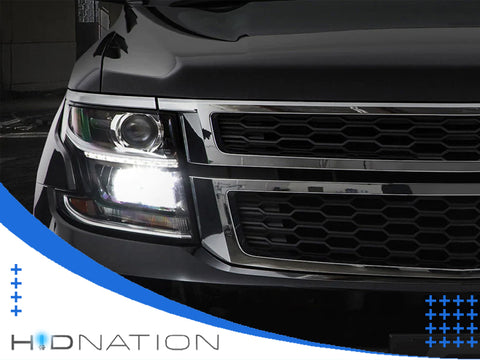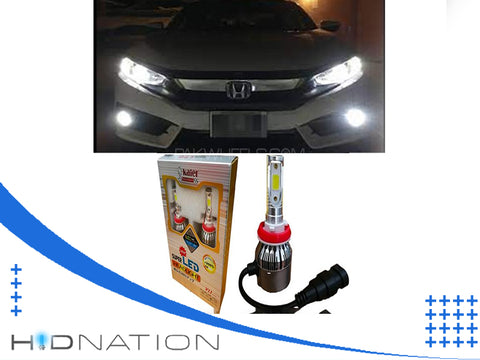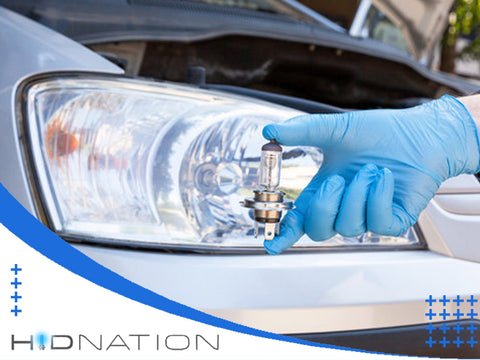Headlight bulbs are an important part of your car, as they help you see in poor weather conditions like fog and rain. They also illuminate the road ahead of you and reduce eye strain while driving.
However, choosing the right bulb can be tricky. It is advisable to know the difference between different types of headlight bulbs and choose the ones that are most suitable for your vehicle.
Increased Visibility
Some benefits come with upgrading to H4 headlight bulbs for your car. These include increased visibility, reduced eye strain, increased safety, and more.
When you upgrade your H4 headlights, you’re increasing the amount of light your car produces and the quality of that light. The new bulbs will produce a clear, white, and 300% brighter light than traditional halogen lights, and they will last up to five years longer!

The first benefit you’ll notice from upgrading to an H4 bulb is increased visibility. The omnidirectional nature of halogen bulbs means that the beam isn’t focused correctly, which makes it difficult to see. This is especially true for LEDs, which don’t have any ways to bend or reflect their light to ensure that it’s properly directed.
Another benefit of upgrading to an H4 headlight bulb is that you’ll get a more even light distribution across your vehicle’s front end. This is because the filament in a 9003 (HB2/H4) bulb has two wires that produce light rather than just one.
As you can imagine, this is a big advantage if you want to see as much of the road as possible. That’s why choosing the right bulb for your vehicle is so important.
The best way to know which type of bulb you need is to check your owner’s manual or go online to find the correct model. Then, you’ll need to pay close attention to the type of socket that the replacement bulb needs. Many different types of bulbs have different socket sizes and angles, so it’s important to ensure you’re getting the right fit.
Reduced Eye Strain
When it comes to reducing eye strain, one of the best options is upgrading to H4 headlight bulbs for your car. In addition to offering a brighter light beam, H4 bulbs are also designed to last longer than standard halogen bulbs.
Several types of H4 headlight bulbs are available, so it’s important to choose the right ones for your vehicle. This includes selecting the correct bulb wattage for your specific vehicle and considering whether you want a low or high-beam bulb.

Some of the more common headlight bulb types are LED, Xenon/HID, and halogen. While they may all seem like great alternatives, it’s important to understand how each type of bulb works before you purchase them.
For example, LED bulbs are a newer technology, and many of them have been designed with road legality in mind. This means they won’t pass an MOT or be E-marked, so you’ll need to check with your local garage before installing them in your vehicle.
These bulbs are a good choice for drivers who are looking for a combination of increased brightness and a more stylish white beam pattern. While these bulbs are a little more expensive than other types of lights, they are a great option for anyone who wants to improve their lighting on the road without breaking the bank.
When you’re driving at night, it’s important to be able to see as much as possible. This will increase your safety and allow you to be more aware of the surrounding environment. In addition, upgraded headlights will reduce your risk of getting a blown bulb and can save you money in the long run.
Increased Safety
Upgrading your car’s headlight bulbs can improve visibility and safety for yourself, other drivers, and pedestrians. There are three main bulb types – halogen, HID, and LED – and all work differently to improve the lighting on the road.
Halogen headlight bulbs are the oldest and remain the most common type used in vehicles today. They emit a yellow-white light and are available in many different wattages. They’re also the least expensive and can last for up to 800 hours.

Despite being the most popular, they’re not the best option for improving your car’s headlights. HID and LED lamps offer a greater range of color temperatures that can increase visibility and reduce eye strain.
Aside from being cheaper and longer-lasting than halogen bulbs, LED bulbs also produce much less heat. That means they’re safer for your engine and your vehicle’s electrical system.
As a result, manufacturers developed a replacement bulb called 9003, similar to H4s but designed and manufactured using tighter tolerances. This allowed 9003 bulbs to be installed in American-spec vehicles without spoiling the beam pattern while still ensuring oncoming drivers were able to see.
If you’re looking for a great upgrade that’s easy to install and won’t cause problems on the road, you should consider investing in a high-quality LED bulb kit from a mobile enhancement retailer. These kits typically feature solid aluminum casings that soak up excess heat and a built-in fan that helps to cool the bulbs. These kits are also made to withstand shock and abrasion, and they come with a 5-year warranty.
Reduced Heat
Having a bulb that generates less heat can make it easier for you to keep your HID headlights in good working condition. This is especially true if you often drive in areas with cold temperatures or experience vibrations on rough roads.
Upgrading to H4 bulbs can also improve your headlights’ lifespan. These types of bulbs typically don’t have any moving parts, which means they’re less likely to be damaged by vibrations or other factors that could cause them to break down prematurely.
This makes them a great choice for car owners who want to save money and increase the lifespan of their headlights. Plus, they’re a lot easier to maintain than xenon bulbs.
However, you should be aware that some halogen headlight bulbs do generate more heat than others. This is because these bulbs are designed to burn hotter to achieve lighter.
The increased temperature of the filament can also cause the filament to break down faster, which isn’t safe for you or other drivers on the road. Luckily, this problem isn’t usually a concern for most drivers because most lighting manufacturers have found ways to decrease the amount of heat that bulbs produce without negatively impacting their performance.
For example, some halogen bulbs can be purchased with a special blue filter to reduce their heat output and improve their lighting efficiency. This blue filtration doesn’t improve the overall brightness of the bulb, and it reduces the light that is reaching your car’s vision.
On the other hand, LED headlight bulbs have a built-in fan to help keep them cool. This fan is designed to prevent the headlight housing from getting too warm, and it can help extend the lifespan of your bulbs.
Less Maintenance
Upgrading to H4 headlight bulbs is an easy way to improve your vehicle's lighting. It also comes with several benefits, including increased visibility and safety.
A major reason why people upgrade their headlights is to improve the brightness of the lights. These bulbs are typically much brighter than standard halogen headlights and last longer.
There are a few different types of headlight bulbs, and each type is suited for a specific use. For example, some vehicles may have a dipped beam (low beam) and a main beam (high beam).
Some cars even have a dipped and main beam in one bulb referred to as a twin filament. This is a great choice for drivers who want to save time and money by upgrading their dipped beam and main beam at the same time.
Another option is to purchase a pair of LED headlight bulbs. These bulbs are typically more expensive than conventional halogen bulbs, but they are generally cheaper in the long run due to reduced maintenance.
They are also more efficient, resulting in less heat and energy usage. They are also easier to install because they do not require a fan to cool them down and last much longer than halogen bulbs.
Conclusion
The LEDs are designed to mimic the filament of halogen bulbs, which results in closely matched beam patterns. This is a significant benefit because it allows you to upgrade to better-performing headlights without having to worry about compatibility with your car's headlamps.
Read Also: Why a Wonderful Improvement for Nighttime Driving Is H1 Headlight Bulbs?
However, there are a few things to consider before you make the switch. First, you should check that the LED bulbs are compatible with your car's make and model. You should also ensure the bulb is compatible with your vehicle's wiring system. This will ensure that the LEDs communicate correctly with your vehicle's computer system and avoid "bulb out" errors.
FAQs
What Are H4 Bulbs Used For?
Headlight bulbs are used to illuminate the road and provide a visible signal for other vehicles.
They come in a variety of different bulb fittings and base types. The most common are H1, H3, and H7, each with two prongs on the base.
Is it Worth Upgrading Headlight Bulbs?
Upgrading headlight bulbs is a smart way to improve your vehicle’s visibility. Better lights help you see more clearly at night, and they make it easier for other drivers to see you.
Upgrade your dipped and main beam bulbs at the same time to achieve a uniform look. This could save you both time and money.
What Does H4 Mean In Car Lights?
There are many different types of bulbs available for headlights and fog lights. Understanding the importance of different types is critical for getting the right bulb for your vehicle.
Halogens are a common option for increased visibility at night, while LEDs offer high power and long life. Knowing what kind of bulb your car needs will help you decide if an upgrade is in order or if you're just replacing a burned-out bulb.
Will Replacing Bulbs Make Headlights Brighter?
If you're frustrated by your headlights' dim performance or looking for ways to make them brighter, it's time to look at upgrading. Replacing your bulbs is one of the easiest car maintenance jobs you can do; it's affordable and can make a major difference in safety on the road.



